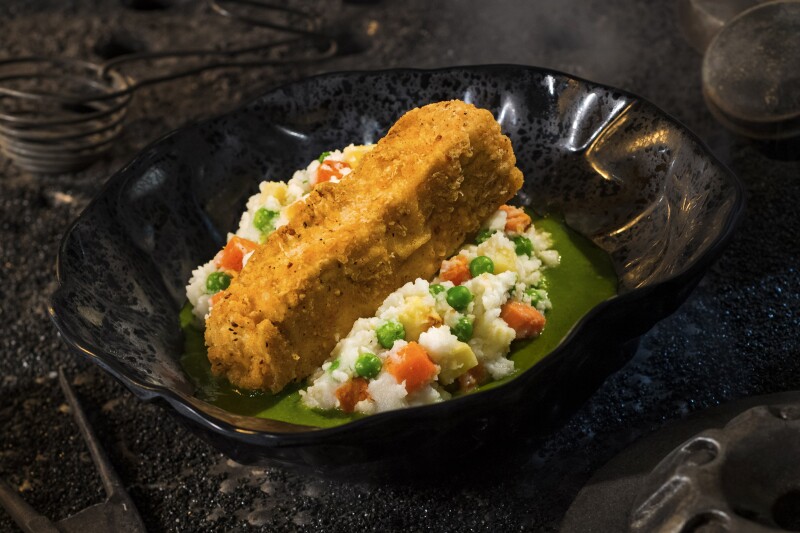Given the vast Star Wars lore that’s been circulating for over 40 years, there’s surprisingly little mythology surrounding the food. The blue milk that Luke Skywalker drinks on Tatooine in the 1977 film has become iconic, and Rey has what can best be described as inflatable green bread in The Force Awakens (2015), but that’s about all fans have to go on. So how does the Walt Disney Company go from milk and bread to five restaurants and stands with distinctly different offerings?
As is the case with everything Disney creates, it starts with the story. When Disney Parks embarks on a new project—whether it’s a restaurant, a hotel, a ride, or a show—the conceptualization begins with a narrative and world in which the experience takes place. Luckily, there’s no shortage of expertise on the Star Wars universe, so when imagineers approached the culinary team with the challenge of developing menus for Galaxy’s Edge, the food and beverage crew made a visit to Skywalker Ranch (after watching all the Star Wars movies, of course).
But the consultants at Lucasfilms didn’t have much to offer beyond what was already in the movies, forcing chefs to dig deeper and ask about the climates and landscapes of fan-favorite planets. Could berries grow in the forests of Endor? Would inhabitants of an icy planet like Hoth rely on root vegetables and preserves? Since pod racing was big on Tatooine, might people/aliens/droids use a discarded engine to grill street food? (The answer at Ronto Roasters is yes, a droid can definitely grill sausage on a pod racer engine.)

The Ronto Wrap piles roasted pork, grilled sausage, and tangy slaw in soft pita.
Courtesy of Disney
The process forced chefs to think outside the galaxy while also allowing them to to create dishes that would challenge guests’ perception of earthly dining. For instance, chef Gary Jones, Disney’s culinary dietary specialist, was instrumental in developing the Ithorian Garden Loaf, which looks like meat but is actually plant-powered. By drilling into the details, the culinary team did more than learn; they ultimately contributed to the Star Wars canon by being the first to define the scents and flavors of that universe. Once chefs had an idea of what flavors they’d be working with, they faced the challenge of aesthetics. What does space food look like? Determined to do better than the dehydrated “astronaut ice cream” that every ’90s kid regretted begging for, the team sent their creativity into hyperdrive with textures and appearances, using popping boba pearls to layer the elements of surprise in beverages and adding some kick to the popcorn at Kat Saka’s Kettle stand for a spicy-sweet treat.
They also tapped into techniques less commonly used in quick service kitchens—the blocky “tip-yip” at Docking Bay 7 Food and Cargo is an unusual cut of sous vide chicken, meaning it’s cooked very slowly at a controlled temperature in a water bath until done all the way through, after which the chicken is fried or roasted to get some color on the outside. (Though meat that has been prepared via sous vide is safe to eat without any additional preparation, a rectangular hunk of gray-white mass not the most appetizing thing to look at.)

The Fried Endorian Tip-Yip at Docking Bay 7 Food and Cargo comes with roasted veggies mixed in mashed potatoes and an herb gravy.
Courtesy of Disney
While the culinary team experimented in the kitchen, imagineers provided constant input—on looks, on flavors, on names, on the types of glasses for each drink, on everything. Some of the imagineers’ ideas were easy to tackle—when one suggested a Fuzzy Tauntaun, Brian Koziol, the food and beverage concept and development director, immediately knew that the beverage would be a take on a Fuzzy Navel. Others, like the Blue Bantha Milk, presented additional challenges. Since not many people in sunny Florida or Southern California want to walk around with a glass of milk, the famous blue beverage at the Milk Stand is actually a dairy-free blend of coconut milk, rice milk, and tropical flavors. Chefs also experimented heavily with a Bantha-inspired cookie that could be served with the drink and made en masse to meet the inevitably high demand of thousands of guests each day. A similar treatment was given to the Bloody Rancor, which is a sleek take on the Bloody Mary with a meringue rancor bone.

Garnishes are as important as the drinks themselves at Oga’s Cantina, as demonstrated by the zero-proof Blue Bantha Milk (middle left) and the boozy Bloody Rancor (middle right).
Courtesy of Disney
Beyond the food created specifically for Galaxy’s Edge, creative packaging came into play. Disney collaborated with breweries and wineries on some special pours that keep the drinks feeling foreign (in a good way). Since nothing breaks immersion like seeing someone drinking a can of Bud Light next to a Stormtrooper, Oga’s Cantina instead offers White Wampa Ale from Ballast Point, Bad Motivator IPA from Sierra Nevada, Imperial Guard wine from Sonoma, and several other options that feel true to Star Wars. Even the name brand sodas come in eye-catching vessels that are unique to the theme park. At the end of the day—or at the edge of the galaxy—it all comes back to storytelling. Chefs and imagineers spent years researching the ecology of fictional worlds and conceiving their food, not just because it was a fun opportunity but also because Star Wars: Galaxy’s Edge promises an immersive experience, and visitors won’t feel like they’re walking around another planet if they’re eating hamburgers they could get in Tomorrowland or at In-N-Out or pretty much anywhere in the United States. The attention to detail, narrative drive, and ambition to create something that’s never been seen before are what make eating at Galaxy’s Edge special.
Star Wars: Galaxy’s Edge is now open at Disneyland Resort in Anaheim, California. It opens at Walt Disney World Resort in Orlando, Florida, on August 29.











